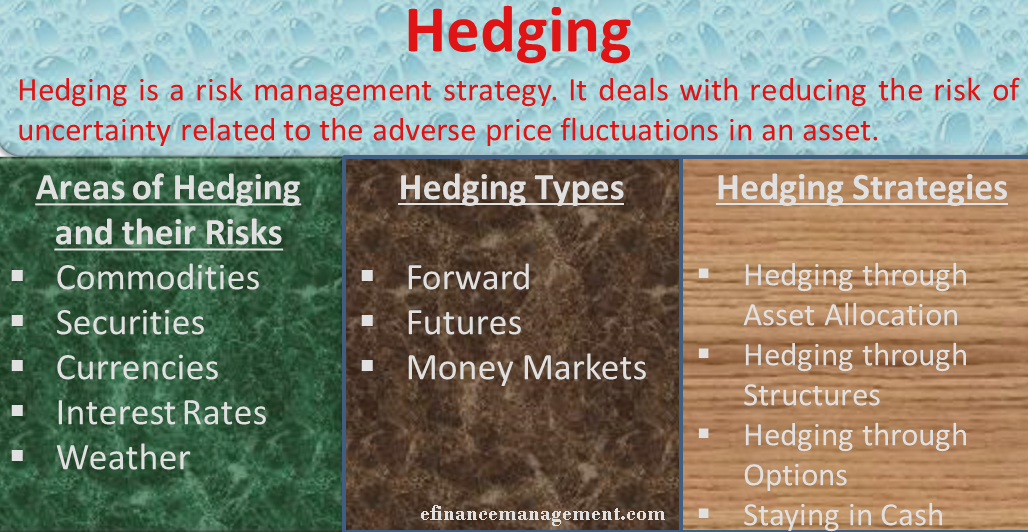Hedging Meaning
Hedging in finance is a risk management strategy. It deals with reducing or eliminating the risk of uncertainty. This strategy aims to restrict the losses that may arise due to unknown fluctuations in the investment prices and to lock the profits therein. It works on the principle of offsetting, i.e., taking an opposite and equal position in two different markets. In simple terms, it is hedging one investment by investing in some other investment.
Generally, when people plan to hedge, they try to insure themselves against a negative event. This does not prevent the event from occurring, but it surely reduces its impact. Individual investors and portfolio managers, and large corporations also use this hedging technique to minimize the exposure to various types of risks and decrease the negative impact thereon.
Hedging Example
Let us understand Hedging by a simple example.
When you buy a life insurance policy, you support and secure your family’s future in case of your death or any severe injury in some accident.

Similarly, when you secure your ‘A’ investment’s loss by offsetting it with ‘B’ investment’s profit, it is known as ‘Hedging.’
Areas of Hedging and their Risks
A business can implement a hedging technique in the following areas:
Commodities
Commodities include agricultural products, energy products, metals, etc. The risk associated with these commodities is known as “Commodity Risk.”
Securities
Securities include investments in shares, equities, indices, etc. The risk associated with these securities is known as “Equity Risk” or “Securities Risk.”
Currencies
Currencies include foreign currencies. There are various types of risks associated with it. For Example, “Currency Risk (or Foreign Exchange (Currency) Exposure Risk),” “Volatility Risk,” etc.
Interest Rates
Interest rates include lending and borrowing rates. The risks associated with these rates are known as “Interest Rate Risks.”
Weather
Interestingly, the weather is also one of the areas where hedging is possible.
Hedging Types
Depending on these areas, it has broadly three types
Forward
Forward (or a Forward Contract) is a non-standardized contract to buy or sell an underlying asset between two independent parties at an agreed price and a specified date. It covers various contracts like forwarding exchange contracts for currencies, commodities, etc.
Futures
Futures (or a Futures Contract) is a standardized contract to buy or sell an underlying asset between two independent parties at an agreed price, standardized quantity, and a specific date. It covers various contracts like currency futures contracts, etc.
Money Markets
It is one of the major components of financial markets; today, where short-term lending, borrowing, buying, and selling are done with a maturity of one year or less. Money markets hedge cover a variety of contracts like money market operations for currencies, money market operations for interest, covered calls on equities, etc.
Hedging Strategies
A hedging strategy generally refers to the risk reduction technique of investment. There can be no standard strategy to hedge various financial instruments like forwarding contracts, options, swaps, or stocks because these strategies require constant modification as per the type of market and investment, which requires hedging. To face such situations, a business can implement a few strategies, which are as follows:
Through Asset Allocation
You can do this by diversifying your portfolio with more than one type of asset. E.g., you can invest 70% in equity and the rest 30% in other more stable assets to create a balanced portfolio.
Through Structures
You can do this by investing a portion of the portfolio in debt and the other in derivatives. Where the debt portion brings stability to the portfolio, the derivatives help in protecting it from the downside risk.
Through Options
You can do this by buying a put option to protect a portfolio of the cash market.
Staying in Cash
It is a ‘No Investment’ strategy. Here, the investor does not invest in any asset and thereby keeps his cash in hand.
Conclusion
Hedging is one of the best means to reduce the unpredictable nature of a portfolio by minimizing the risk of loss. This, in turn, helps the market run in an orderly and efficient manner.
Quiz on Hedging
Let’s take a quick test on the topic you have read here.


RealLy you have explained Hedging in very easy way.
It is appreciable
Thanks for this article
You are most welcomed. Sunil. We have also covered most hedging types in other posts.
good
Sir why do people hedg between above strike price and below strike price call and put in option.
I WANT TO EXPLANATION OF HEDGING LOSS OR GAIN BETWEEN BANK
EXAMPLE:
I BOOKED A CONTRACT FOR INR TO USD @ 74.50 FOR 1.00LAKH USD ON 01/07/2021 TO ONE YEAR VALIDITY
I CANCELLED THE CONTRACT ON 31/07/2021 SOME INTERNAL REASON THAT TIME OF SPOT RATE USD1 = INR75.50 IS THIS CONTRACT PROFIT OR LOSS?
Prima facie there is a gain in the contract (75.50-74.50) Re 1 per quantity. However, this depends upon the quantum of premium you have paid for booking the contract. If the premium is < 1 Lakh (1*100000) then you are at a profit or vice versa.